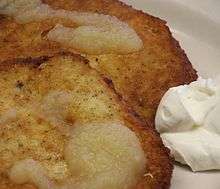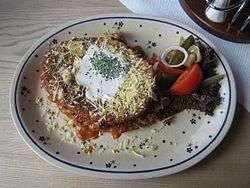Potato pancake
 Potato pancakes with apple sauce and sour cream | |
| Type | Pancake |
|---|---|
| Main ingredients | Potatoes, flour, chicken egg, cooking oil |
|
| |
Potato pancakes, latkes or boxties are shallow-fried pancakes of grated or ground potato, flour and egg, often flavored with grated garlic or onion and seasoning. They may be topped with a variety of condiments, ranging from the savory (such as sour cream or cottage cheese), to the sweet (such as apple sauce or sugar), or they may be served plain. The dish is sometimes made from mashed potatoes to make pancake-shaped croquettes.[1]
In different cultures

Potato pancakes are associated with the cuisines of many European and Middle Eastern century-old traditions including German and Austrian (as Kartoffelpuffer, Reibekuchen, Reiberdatschi, Erdäpfelpuffer and Erdäpfellaibchen), Belarusian (as дранікі draniki), Bulgarian (as patatnik), Czech (as bramborák or cmunda), Hungarian (as tócsni and other names), Iranian (as kotlet or cutlet), Jewish (as latka, Yiddish: לאַטקע,[2] Hebrew: לביבה levivah, plural לביבות levivot), Latvian (as kartupeļu pankūkas), Lithuanian (as bulviniai blynai), Luxembourg (Gromperekichelcher), Polish (as placki ziemniaczane), Russian (as драники draniki), Slovak (as zemiakové placky, haruľa or nálečníky), Ukrainian (as деруни deruny) and any cuisine that has adopted similar dishes.
It is the national dish of Belarus. In Germany, potato pancakes are eaten either salty (as a side dish) or sweet with apple sauce,[3] or blueberries, sugar and cinnamon; they are a very common menu item during outdoor markets and festivals in colder seasons (especially at Christmas markets). In Swiss cuisine, Rösti is a variation that never contains egg or flour. Potato pancake is a traditional favorite in the southern parts of Indiana during holiday festivities.[4]

British tattie fish
In the North-East of England (particularly County Durham), there is a popular dish known as tattie fish, because the pancake resembles a deep fried piece of fish. The pancake consists of flour, eggs, shredded potatoes and onions. Some people add tomato or cheese to the mix, depending on taste. The British also brought the potato pancake to present-day Zimbabwe, Africa, while a colony of the British Empire. They are still eaten today, where they are an affordable dish.
Irish boxty
A form of potato pancake known as boxty (Irish: bacstaí) is a popular traditional dish in most of Ireland, particularly north Connacht and southern Ulster. It is made similarly to the British tattie fish, with more starch, and often with buttermilk and baking soda. It has a smooth, grained consistency.
Jewish latke
Latkes or latkas (לאַטקע) are potato pancakes that Ashkenazi Jews have prepared as part of the Hanukkah festival[5] since the mid-1800s,[6] based on an older variant of the dish that goes back to at least the Middle Ages.[7]
Latkes need not necessarily be made from potatoes. Prior to the introduction of the potato to the Old World, latkes were, and in some places still are, made from a variety of other vegetables, cheeses, legumes, or starches, depending on the available local ingredients and foods of the various places where Jews lived.[8] Numerous modern recipes call for the addition of ingredients such as onions and carrots.[9][10]
The word latke itself is derived (via Yiddish) from the Russian word ladka, oladka, a diminutive from oladya (оладья), "small pancake". The word leviva (לביבה), the Hebrew name for latke, refers in the Book of Samuel to a dumpling made from kneaded dough, as part of the story of Amnon and Tamar.[11] Some interpreters have noted that the homonym levav (לבב) means "heart," and the verbal form of l-v-v occurs in the Song of Songs as well. In the lexicon of Ashkenazi Jews from Udmurtia and Tatarstan there are recorded versions of the kosher-style appellation of latkes (draniki, dranki, krezliki, kremzliki, kakorki, etc.) during the eight-day Hanukkah holiday.[12]
Korean gamja-jeon
Gamja-jeon (감자전; lit. "potato pancake") is a Korean pancake made by pan-frying in oil the mixture of grated potato and potato starch.
Swedish rårakor
The Swedish version of unbound potato pancakes is called rårakor.[13] When prepared with a batter of wheat flour, milk, egg, and shredded potatoes and fried like thin pancakes, they are called raggmunk, the word ragg means crispy and munk derives from the Swedish munkpanna, which is literally translated as donutpan.[14] Both kinds are enjoyed with fried pork and lingonberry jam.
Polish placki ziemniaczane

Potato pancakes, literally translated in Polish as placki ziemniaczane, are often served in Poland topped with meat sauce, pork crisps or goulash, as well as sour cream, apple sauce, mushroom sauce,[15] and cottage or sheep's cheese or even fruit syrup. Placki ziemniaczane was a food staple at the 17th-century Polish monasteries according to written recipe from Stoczek Warmiński with one onion, two eggs and a spoonful of wheat flour per each kilogram of potatoes, served only with salt and pepper.[16] In the 19th century,[17] especially in times of economic difficulty during the foreign partitions, potato pancakes often replaced missing bread among the peasants. The lower-quality crops given to field laborers were sometimes turned by them quickly into pancakes to improve taste and prolong freshness.[18] Also, their popularity is closely associated with the historic presence of one of the largest Jewish communities in the world flourishing in Poland.[17]
The largest potato pancake (possibly in the world), measuring 2 meters and 2 centimeters, was made during the annual two-day celebrations of Świt Plinzy (Plinza Dawn festival) in Rzechta, Poland (see photo). The tongue-in-cheek games in Rzechta include the throwing of bad potato pancake, with the record of 29 meters.[19]
Czech bramborák
A Czech potato pancake is called bramborák (from brambor, potato) and it is made of grated potatoes with egg, breadcrumbs or flour and seasoning (salt, pepper, most importantly garlic and marjoram; sometimes ground, cracked or whole caraway seeds) and is served as it is. Some regional versions blend in dough, sauerkraut, and/or sliced smoked meat. The same potato dough is used also as coating of fried pork chop called kaplický řízek.
Iranian kuku sib zamini
In Iranian cuisine, kuku sib-zamini (Gilaki: کوکو سیب زمینی, "potato kuku") is made with shredded potatoes, onion, saffron, sometimes garlic chives and sometimes cinnamon. Frequently, potato kuku is cooked as smaller patties, but it is also cooked in a larger pancake-style or baked.[20] This dish has been compared to the latke, Rösti, and tortilla Española (Spanish omelette).
See also
| Wikibooks Cookbook has a recipe/module on |
| Wikimedia Commons has media related to Potato pancakes. |
- Korosten, a town in Ukraine that hosts an annual potato pancake festival
- Latke-Hamantash Debate
-
 Food portal
Food portal
References
- ↑ "Mashed potato pancake recipe". All-about-potatoes.com. Retrieved 2011-12-25.
- ↑ Comprehensive Yiddish–English Dictionary, 359
- ↑ "Potato pancakes recipe at "Whats Cooking Dad?"". Whatscookingdad.com. 2009-01-06. Archived from the original on 2012-02-20. Retrieved 2011-12-25.
- ↑ "News Quiz: Special Holiday Edition". 2011 Southern Indiana Current Magazine. Retrieved December 8, 2011.
- ↑ Koenig, Leah. Modern Jewish Cooking: Recipes & Customs for Today's Kitchen. Chronicle Books. p. 119. ISBN 9781452132327. Retrieved 22 December 2015.
- ↑ Marks, Gil. Encyclopedia of Jewish Food. Houghton Mifflin Harcourt. p. 707. ISBN 0544186311. Retrieved 22 December 2015.
- ↑ http://www.pbs.org/food/features/history-of-latkes/
- ↑ Appelbaum, Yoni (11 December 2015). "Everything You Know About Latkes Is Wrong". The Atlantic. Retrieved 22 December 2015.
- ↑ Rachel Ray, Quick Potato and Carrot Latkes, The Food Network, December 20, 2008.
- ↑ Philip and Karen Selwyn, Potato-carrot-onion Latkes, rec.food.cuisine.jewish archives, Oct. 11, 1998, 1:00 AM.
- ↑ DLC (2006-12-18). "Analysis of the word "latke"". Balashon. Retrieved 2011-12-25.
- ↑ Altyntsev A.V., "The Concept of Love in Ashkenazim of Udmurtia and Tatarstan", Nauka Udmurtii. 2013. № 4 (66), p. 131. (Алтынцев А.В., "Чувство любви в понимании евреев-ашкенази Удмуртии и Татарстана". Наука Удмуртии. 2013. №4. С. 131: Комментарии.) (in Russian)
- ↑ "Recipe for ''rårakor'' on chef2chef.net". Recipes.chef2chef.net. Retrieved 2011-12-25.
- ↑ sv:Raggmunk
- ↑ Krzysztof Kucharski, "Nie wszyscy pewnie wiedzą.." (Not everybody knows). Gazeta Wrocławska, Poland, 2008-08-22. (in Polish)
- ↑ "Placki ziemniaczane". Kącik kulinarny (in Polish). Szlak Pielgrzymkowy - Święte Miejsca Warmii. Retrieved December 31, 2012.
- 1 2 Krzysztof Kucharski, "Nie wszyscy pewnie wiedzą.." str. 3 (Not everybody knows, p. 3). Gazeta Wrocławska, Poland, 2008-08-22. (in Polish)
- ↑ Different recipes for "placki ziemniaczane" at Onet.pl (in Polish)
- ↑ "Wysmażyli największy placek ziemniaczany świata" [They made the largest pancake in the world)]. Święto plinzy Rzechta 2011 in Echo Turku (Plinza holiday in Rzechta) (in Polish). Wydawnictwo - Przegląd Koniński (publishing). August 2011. Retrieved December 31, 2012.
- ↑ "Kuku-ye Sibzamini (Potato Patties)". Vida Vitality, Bad Assing it All The Way. VidaVitality.com. March 25, 2014. Retrieved October 13, 2014.
